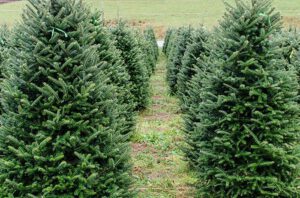Last weekend I enjoyed running the Little River trail run, a great event put on…
 There is nothing that sets off winter ennui quite like seeing Christmas tree carcasses tossed along the roadside in January. Live Christmas trees are undoubtedly better for the environment than artificial trees, but there are multiple ways to extend the use of your tree beyond the holiday season.
Most municipalities have live Christmas tree collections where trees are chipped and used for mulch. The cities of Raleigh, Chapel Hill, and Cary all pick up trees as yard waste from residents and use them for mulch in city parks. The City of Durham has six drop-off sites that are accepting trees throughout January and February. All municipalities require that the trees be free from all adornments- no trees with remaining lights, tinsel, or ornaments will be accepted.
On the coast, Christmas trees are collected for a very different purpose. The discarded evergreens are used for dune restoration efforts and act as biodegradable sand fences by capturing wind-borne sand, therefore, building up dunes. However, this usage is contested because the trees can easily become a nuisance if they are dislodged in a storm. To be effective coastal restoration tools, Christmas trees must be used in conjunction with native grass species and their location must take into account the nesting areas of shorebirds. Christmas trees are a low-cost, effective, and biodegradable method for slowing coastal erosion. If you are located on the coast, consider donating your Christmas tree to local beach renourishment projects. Fort Macon State Park, Oak Island Beach Preservation Society, and Hammocks Beach State Park are just a few places along the North Carolina coast collecting Christmas trees and volunteer help for dune restoration.
One tree disposal method endorsed by the US Army Corps of Engineers is to submerge it in bodies of water to benefit fish habitats. The conifer’s complex structure provides a reef-like refuge for many species of fish and invertebrates as well as food sources for microorganisms. Another advantage of using Christmas trees for fish habitat is that they decompose in 3-5 years unlike plastic “fish attractors”. A lake near you may be accepting Christmas trees, but if you are lucky to have your own private body of water and want to benefit aquatic life, consider weighing down and submerging the old Tannenbaum.
If you live far from the coast, a body of water, and live in an area that tosses Christmas trees in the landfill, hügelkultur may be the ecological solution for you. Hügelkultur is a German permaculture technique meaning “mound culture” in which a raised bed is constructed with logs, branches, compost, and leaf debris and covered with topsoil. You can then plant vegetables, perennials, or annuals on top of the mound, and as the wood decays, it provides moisture and nutrients. A Christmas tree is a perfect base for a hügelkultur bed and you can watch how its decomposition gives new life all year long.
Firs and spruces grow for years to become brief symbols of Christmas in our homes, and how we dispose of them matters. Let us know how you decide to use your Christmas tree to benefit our ecosystems far beyond the holiday season!
This blog post was written by Madeline Joslin, member of Resilience Corps NC, an AmeriCorps program run by Conservation Trust for North Carolina and funded through a federal grant awarded by NC's Commission on Volunteerism and Community Service.
There is nothing that sets off winter ennui quite like seeing Christmas tree carcasses tossed along the roadside in January. Live Christmas trees are undoubtedly better for the environment than artificial trees, but there are multiple ways to extend the use of your tree beyond the holiday season.
Most municipalities have live Christmas tree collections where trees are chipped and used for mulch. The cities of Raleigh, Chapel Hill, and Cary all pick up trees as yard waste from residents and use them for mulch in city parks. The City of Durham has six drop-off sites that are accepting trees throughout January and February. All municipalities require that the trees be free from all adornments- no trees with remaining lights, tinsel, or ornaments will be accepted.
On the coast, Christmas trees are collected for a very different purpose. The discarded evergreens are used for dune restoration efforts and act as biodegradable sand fences by capturing wind-borne sand, therefore, building up dunes. However, this usage is contested because the trees can easily become a nuisance if they are dislodged in a storm. To be effective coastal restoration tools, Christmas trees must be used in conjunction with native grass species and their location must take into account the nesting areas of shorebirds. Christmas trees are a low-cost, effective, and biodegradable method for slowing coastal erosion. If you are located on the coast, consider donating your Christmas tree to local beach renourishment projects. Fort Macon State Park, Oak Island Beach Preservation Society, and Hammocks Beach State Park are just a few places along the North Carolina coast collecting Christmas trees and volunteer help for dune restoration.
One tree disposal method endorsed by the US Army Corps of Engineers is to submerge it in bodies of water to benefit fish habitats. The conifer’s complex structure provides a reef-like refuge for many species of fish and invertebrates as well as food sources for microorganisms. Another advantage of using Christmas trees for fish habitat is that they decompose in 3-5 years unlike plastic “fish attractors”. A lake near you may be accepting Christmas trees, but if you are lucky to have your own private body of water and want to benefit aquatic life, consider weighing down and submerging the old Tannenbaum.
If you live far from the coast, a body of water, and live in an area that tosses Christmas trees in the landfill, hügelkultur may be the ecological solution for you. Hügelkultur is a German permaculture technique meaning “mound culture” in which a raised bed is constructed with logs, branches, compost, and leaf debris and covered with topsoil. You can then plant vegetables, perennials, or annuals on top of the mound, and as the wood decays, it provides moisture and nutrients. A Christmas tree is a perfect base for a hügelkultur bed and you can watch how its decomposition gives new life all year long.
Firs and spruces grow for years to become brief symbols of Christmas in our homes, and how we dispose of them matters. Let us know how you decide to use your Christmas tree to benefit our ecosystems far beyond the holiday season!
This blog post was written by Madeline Joslin, member of Resilience Corps NC, an AmeriCorps program run by Conservation Trust for North Carolina and funded through a federal grant awarded by NC's Commission on Volunteerism and Community Service.


